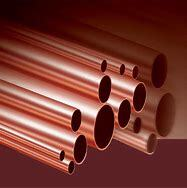1. Introduction
Let’s be honest: when you hear ‘copper rod,’ your brain probably conjures images of sweaty plumbers wrestling with 15mm copper pipe or DIYers soldering aircon copper tubes on a sweltering summer day. But step beyond the hardware store aisle, and you’ll find copper rods doing high-stakes work in places where failure isn’t an option—like grounding skyscrapers during thunderstorms or fusing delicate electronics in zero-gravity simulations.

Far from being just another metal bar, the copper rod wears many hats: earthing rod copper in power substations, copper brazing rod in turbine repairs, and even flexible copper bus bar in electric vehicle battery packs. In this article, we’ll spotlight two niche—but critical—applications where the right choice between a copper bonded ground rod and a pure copper round bar can mean the difference between flawless operation and catastrophic downtime.
2. Copper Rods in Advanced Earthing Systems
2.1 Why Your Building Needs More Than Just a Nail in the Dirt
Lightning doesn’t negotiate. When it strikes, it demands a low-resistance path straight into the earth—fast. That’s where the copper earth rod shines (literally). Unlike makeshift grounding with rebar or galvanized steel, a proper earthing rod copper offers unmatched conductivity and corrosion resistance.
Professionals often choose between solid copper rods and cost-effective alternatives like copper bonded steel or copper clad steel earth rod. The former—pure rod copper—is ideal for corrosive soils or marine environments. The latter, featuring a steel core with a thick copper coating, delivers 90% of the performance at half the copper rod price, making copper bonded earthing rod a favorite for large-scale telecom and solar farms.
2.2 Decoding the Alphabet Soup of Grounding Terminology
Confused by terms like copper clad ground rod vs. copper bonded ground rod? Here’s the skinny:

- Copper bonded steel: Electrolytically bonded copper layer over high-tensile steel—great tensile strength, decent conductivity.
- Copper clad steel earth rod: Similar, but often uses a mechanical cladding process; slightly less durable in harsh conditions.
- Solid copper round bar: The gold standard (well, copper standard) for critical infrastructure like hospitals and data centers.
And yes, folks do search for ‘earthing rod price’ more often than you’d think—especially when comparing a 16mm x 3m copper earth strip 25x3mm price versus bulk orders of copper strip roll for grid-scale projects.
3. Copper Rods in Precision Joining: Beyond Basic Welding
3.1 When You Can’t Afford a Single Bubble in the Joint
Forget stick welding farm gates—advanced industries rely on copper rod for welding tasks where thermal conductivity and purity matter immensely. Think aerospace heat exchangers, cryogenic piping, or even restoring vintage steam locomotives without warping century-old fittings.
Enter copper to copper brazing rods and copper to copper welding rod varieties. These aren’t your dad’s MAPP gas torch accessories. Formulated with precise silver or phosphorus content, they enable capillary action that flows seamlessly between clean copper surfaces, creating joints stronger than the base metal itself.
3.2 Brazing vs. Welding: Does It Matter?

Absolutely. Copper welding rod typically implies fusion welding (melting base + filler), which demands extreme heat and risks oxidation. Copper brazing rod, however, uses lower temps and flux to bond without melting the parent metal—ideal for thin-walled copper tubing or sensitive electronics.
Pro tip: Always match your filler to your base. Using a generic ‘welding rod copper’ on beryllium copper strip could ruin its spring temper. And never—ever—burn copper wire for scrap near your workspace; those fumes will void your warranty and your lunch.
4. Bonus Niche: Copper Strips and Bars in Modern Engineering
While not rods per se, flat cousins like nickel plated copper strip, 1mm copper strip, and flexible copper bus bar often share supply chains and specs with rod copper. Electric vehicle manufacturers use roll of copper strip for battery interconnects, while architects specify copper roof strip or copper edging strip for both aesthetics and lightning dispersion.
Recyclers, meanwhile, obsess over the best way to strip copper wire—debating between manual strippers, thermal methods (please don’t burn it!), and industrial shredders. Spoiler: the fast way to strip copper wire without degrading value is mechanical stripping, not open flames.
5. Conclusion
So next time you see a copper rod, don’t just think ‘plumbing supply.’ Think lightning conductor, spacecraft weld, or EV battery backbone. Whether you’re sourcing a copper bonded steel ground rod for a wind farm or selecting the perfect copper brazing rod for a museum-grade restoration, remember: in the world of precision engineering, the devil—and the conductivity—is in the details. And maybe, just maybe, check the copper rod price before ordering 500 meters of copper strip near me.
Our Website founded on October 17, 2012, is a high-tech enterprise committed to the research and development, production, processing, sales and technical services of ceramic relative materials such as Copper. Our products includes but not limited to Boron Carbide Ceramic Products, Boron Nitride Ceramic Products, Silicon Carbide Ceramic Products, Silicon Nitride Ceramic Products, Zirconium Dioxide Ceramic Products, etc. If you are interested, please feel free to contact us.

